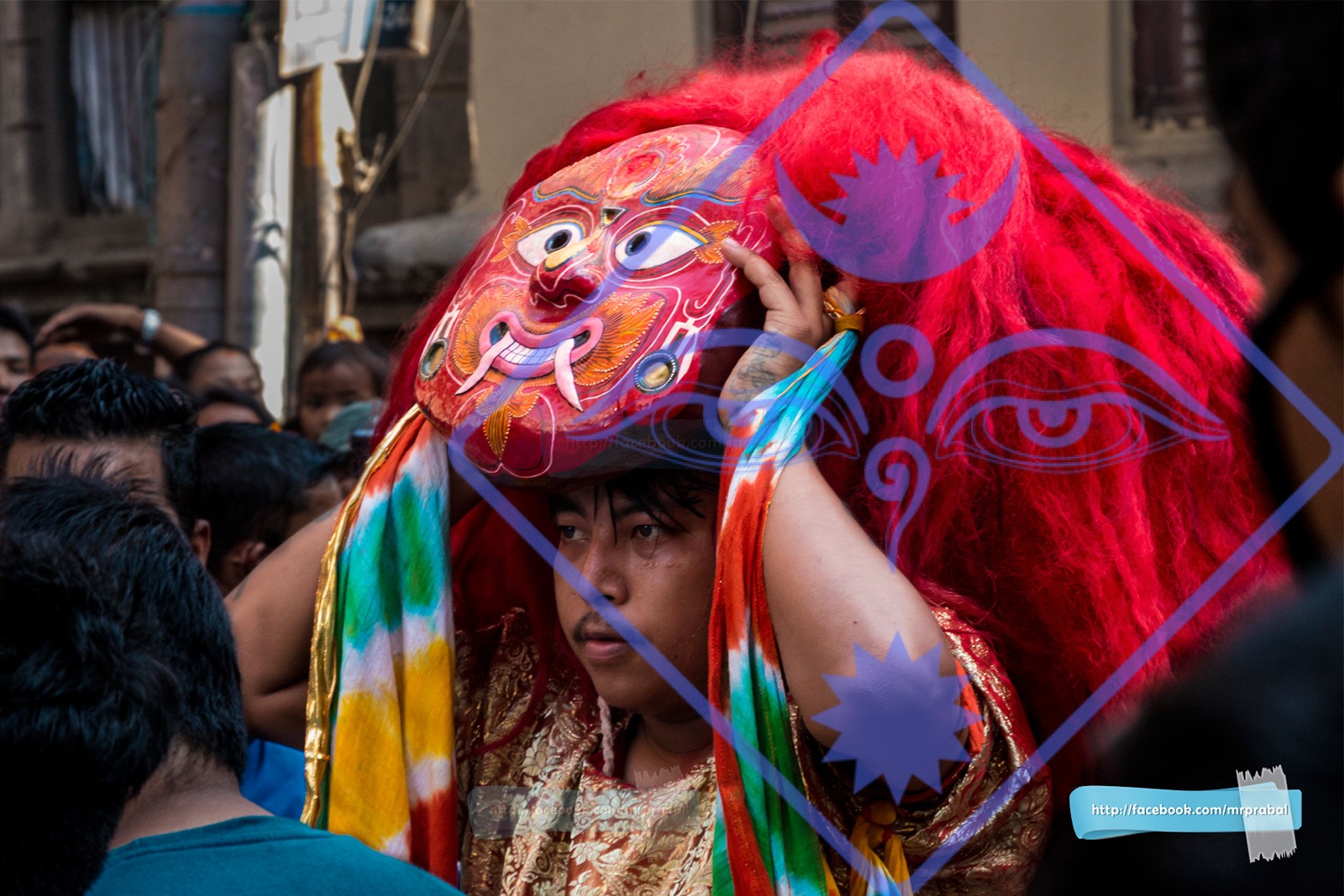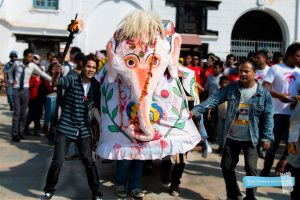
Although Lakhey is frequently seen as a demon, there is more to his tale than meets the eye. Despite being viewed by many as a demon that hunts people, Majipa Lakhey is actually a devoted and watchful character who is honored for his part in defending the populace.
Residents of the Kathmandu Valley look forward to the Indra Jatra celebration each year, which offers colorful processions with Pulu kishi, Halchok Bhairab, Kumari, Bhelu, Ganesh, and Majipa Lakhey Aaju among other figures. The most unique of them, Majipa Lakhey, is worshipped as a manifestation of Calm Bhairab and is only seen for eight days during this festival. Despite the intimidating reputation he bears, his presence is a symbol of care and protection.

The Tale of Kamokamakshya, Taleju, and the Lakheys
The Jyapus farmers faced a grave issue many years ago, when kings ruled over the region that is now known as Kathmandu. Their rice fields produced no grains, and their maize stalks grew without kernels. They feared starvation because of the dire circumstances. They turned to Goddess Taleju for assistance because they were desperate and thought she was the only one who could save them. A group of five Jyapus and numerous Gurjus set out on a perilous trek to the goddess’s residence in Kamokamakshya. They had to overcome many obstacles along the road, including spirits and demons, while they made their way across tough terrain and impenetrable woodlands.
Upon arriving at Kamokamakshya Cave, they were shocked to see a large number of Lakheys engaged in combat. Each one exuded tremendous power and aggression; some were small, some big, some gigantic, and others tiny. With their special power of employing enchanted rice grains to put demons to sleep, the Gurjus were able to calm the majority of the Lakheys. But when they got closer to the cave’s entrance, they came upon Majipa Lakhey, the strongest and most dangerous of them. With an intimidating appearance, he towered above them, acting as the cave’s guardian. He was unaffected by the Gurjus’ magical abilities and fiercely guarded his domain, allowing them no passage.
The Gurjus and Jyapus cried out to Goddess Taleju for help in their desperation. The goddess heard their appeal and moved to interfere, telling Majipa Lakhey to move aside so they might enter. Once inside, they confided in Taleju, who listened to them attentively. She acknowledged their situation, but clarified that she had to take care of the Lakheys, so she was unable to leave the cave to assist them immediately.
The Goddess Taleju said, “My children will spread chaos throughout the land if I leave this place.” But she did gave them an answer. “Take this sword, call it the kharga, and worship it.” Your situation will pass soon, the woman assured me. She also told Majipa Lakhey to return with them to Kantipurnagar and watch over them from other evil forces. She bound him with a promise to never harm humans, ensuring their safe passage back to the city.
Lakhey’s Arrival in Kathmandu
A few months later, Majipa Lakhey’s presence in Kathmandu was accepted by the locals, who saw him as a benefactor rather than a threat. Kathmandu was then a tiny settlement with Teku to the south, Sorahkhutte to the north, Bhadrakali to the east, and Bishnumati to the west. In the heart of the settlement was Basantapur. The people were still wary, but Majipa Lakhey was beginning to win them over. They were still cautious of the kharga’s potential power, so they only permitted the kharga to be taken into the city, leaving Lakhey at the gate.
The city gradually started to flourish once more, with crops growing normally and tranquility returning. But Majipa Lakhey started crying every day. His heartbroken cries reverberated across the city, inciting sympathy in the populace. They could not stand to watch him in such pain, despite the fact that he was a monster. They alerted the king to the situation out of concern.
Curious and sympathetic, the monarch proceeded to talk to Majipa Lakhey. “Why are you crying?” he inquired. Lakhey retorted, “I want to live among people; I am alone here.” I swear to do no harm to anyone. Still doubtful, the monarch enquired, “But what will you eat if you don’t harm us?” He could rest comfortable that Lakhey would only eat meat and eggs. The king chose to comply with his plea after being moved by his earnestness. Majipa Lakhey had no name till then, so the king gave him the name “Lakhey,” which is a combination of the Newari terms “la,” which means meat, and “khey,” which means egg.
The folks remained uneasy despite this promise. They dispatched a child to confront Lakhey in order to gauge his intentions. With no evidence of aggressiveness, the child gently tormented Lakhey, who playfully ran him away. This lighthearted conversation went on, and the boy kept coming back to make fun of Lakhey. One day, Lakhey kicked the child three times out of reflex after becoming a little irritated with his persistent taunting. The boy was called Jhyalincha from that point on, which is a fun appellation that comes from the Newari word meaning a mischievous boy. For this reason, in the Lakhey dance, Lakhey reenacts their fun past by symbolically kicking Jhyalincha three times when he catches him.
Guardian of the Kumari

There is a legend that the goddess Taleju and the ruler of Kathmandu would play dice games. The king once overreached himself and insulted the goddess after having too much to drink. Taleju, offended and furious, vowed to abandon the city without defense. When the monarch realized his error, he asked for pardon. Taleju consented, but with one requirement: she ruled that the Kumari, a living goddess, would be selected from a particular ancestry to guarantee her celestial presence within the city. The Kumari people still follow this custom today.
The deity’s fiercely devoted follower Majipa Lakhey was equally offended by the king’s actions and yearned to depart with her. But Taleju told him to stand back and guard the Kumari and the holy kharga. Lakhey awakens to protect the Kumari and the kharga during the eight days of the Kumari Jatra. He retreats back to his quiet sleep for the remainder of the year. This is how Majipa Lakhey became known as Majipa Lakhey Aaju, the Calm Bhairab, and how the Yenya Puhni celebration got its start. Even though Indra Jatra and Yenya Puhni occur at the same time, it’s vital to remember that they are two separate festivals, each with a unique meaning.
Because of this, Majipa Lakhey Aaju’s narrative is not just about a demon but also about a guardian who, in spite of his menacing appearance, stands watch over the people and their customs.
Click here to watch the Lakey dance performed during Indra Jatra at Lakhe dance during IndraJatra #indrajatra #mrprabal – YouTube




